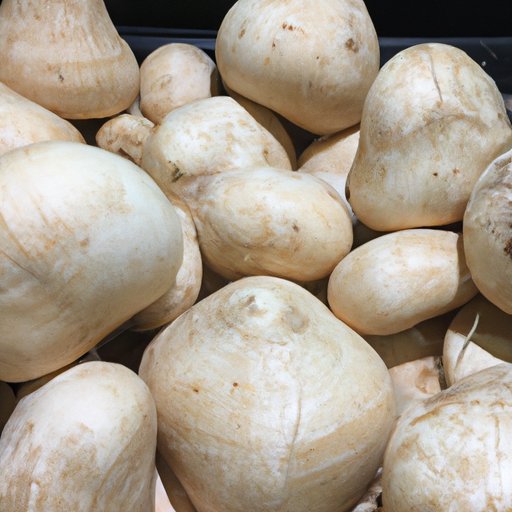
I. Introduction
If you’ve never had jicama before, you’re in for a treat. This crunchy, slightly sweet root vegetable can be eaten raw or cooked and is a great addition to salads, stir-fries, and more. The only downside is that cutting jicama can be a bit tricky. Its hard, fibrous outer layer requires some finesse to remove, and getting uniform slices or cubes can be a challenge. But fear not – we’ve put together this handy guide to help you cut jicama like a pro.
II. Step-by-Step Guide
Before you begin, make sure you’ve chosen a ripe and fresh jicama. Look for one that is firm and heavy for its size, with smooth, unblemished skin. When you’re ready to cut it, you’ll need a few tools: a sharp knife, a sturdy cutting board, and a vegetable peeler.
- Wash your jicama with cool water to remove any dirt or debris. Use a vegetable peeler to remove the tough outer layer of skin. Cut off the ends of the jicama first to create a flat surface to rest it on, then peel from top to bottom.
- Once the jicama is peeled, you can slice it into rounds or cut it into cubes or sticks. To slice it, place the jicama on its side and use a sharp knife to cut it into thin rounds. To cube it or cut it into sticks, slice the jicama into rounds first, then stack the rounds and cut them into desired sizes.
- If you’re using jicama in a salad or other recipe, you may want to julienne it instead. Cut the rounds or sticks into thin, matchstick-like pieces by slicing them lengthwise.
III. Video Tutorial
If you’re a visual learner, check out this short video tutorial on how to cut jicama:
In the video, you’ll see how the jicama is peeled and sliced using a sharp knife. Note how the chef holds the knife securely and uses a sawing motion to cut through the tough flesh.
IV. Recipe Ideas
One of the best things about jicama is how versatile it is. Here are a few recipe ideas to get you started:
- Jicama salad: Peel and slice the jicama into thin rounds, then toss with sliced cucumber, chopped cilantro, lime juice, and a pinch of salt.
- Jicama fries: Cut the jicama into thin, fry-like sticks and toss with olive oil, paprika, garlic powder, and salt. Roast in the oven until crispy.
- Jicama slaw: Julienne the jicama and mix with shredded cabbage, carrots, and a tangy dressing made with lime juice, honey, and Dijon mustard.
Feel free to experiment with these recipes by adding other ingredients or using different seasonings. And if you’re not sure how to cut the jicama for a particular recipe, just follow the steps in this guide!
V. Best Practices
To cut jicama safely and efficiently, keep these tips in mind:
- Use a sharp knife. A dull knife will make it harder to cut through the tough flesh.
- Hold the knife securely. Make sure your grip is firm and stable.
- Use a cutting board. This will protect your counter and provide a stable surface for cutting.
- Remove the tough fibrous layer. If you don’t remove this layer, your jicama will be harder to chew and less flavorful.
VI. Serving Suggestions
Jicama can be used in a variety of dishes, from appetizers to main courses. Here are a few serving suggestions:
- Use jicama as a crudité for dips like hummus or guacamole.
- Add jicama to stir-fries for crunch and sweetness.
- Top tacos or tostadas with diced jicama for extra texture and flavor.
And don’t forget about garnishes – jicama pairs well with cilantro, lime, and chili powder, among other flavors.
VII. Health Benefits
In addition to its delicious taste and crunchy texture, jicama is also packed with nutrition. Here are a few of the health benefits:
- High in fiber: Jicama is a good source of both soluble and insoluble fiber, which can support digestive health.
- Low in calories: Jicama is naturally low in calories and fat, making it a great option for weight loss or weight management.
- Rich in vitamin C: Jicama is loaded with vitamin C, an important antioxidant that can boost immune function and reduce inflammation.
So the next time you’re looking for a healthy, tasty veggie to add to your meal, don’t overlook jicama.
VIII. Jicama Alternatives
While jicama is a unique and flavorful ingredient, there are other vegetables that can be used in its place. Here are a few options:
- Water chestnuts: These crunchy, mild-tasting bulbs are often used in stir-fries and Asian-inspired dishes.
- Chayote: This mild-flavored squash can be sliced or diced and added to soups, salads, or stir-fries.
- Daikon radish: With a peppery bite and a crisp texture, daikon can be used in salads, pickles, or as a substitute for noodles.
While these alternatives are similar to jicama in terms of texture and versatility, they may have slightly different flavor profiles. Experiment with using them in your favorite recipes to see what you like best.
IX. Conclusion
Cutting jicama doesn’t have to be a daunting task – with a little practice and the right tools, you can become a pro in no time. And once you’ve mastered the art of cutting, you can start exploring all the delicious ways to use this unique and nutritious ingredient. From salads to stir-fries to slaws, jicama is a versatile veggie that can add crunch and flavor to any dish.




